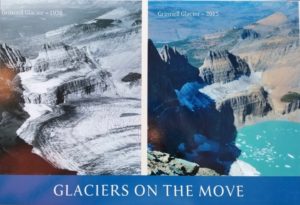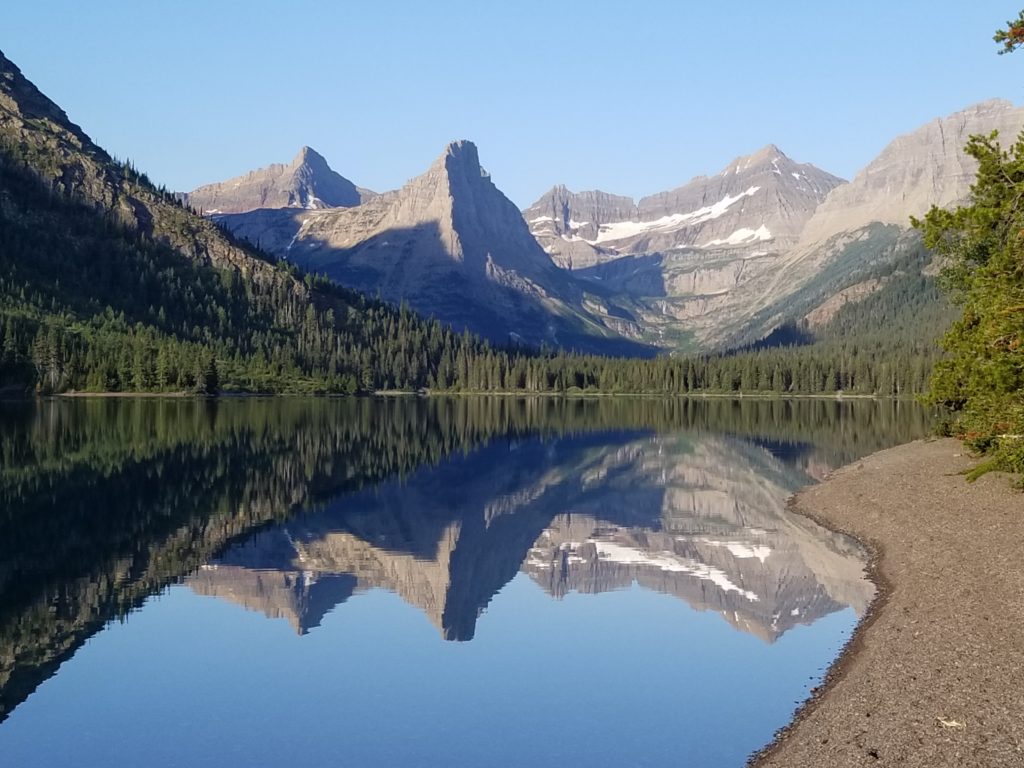Lessons from Glacier National Park, Montana

Because of our changing climate, there is now a new form of tourism – climate tourism. When you open up the Condé Nast Traveler article entitled “10 places to visit before they are lost to climate change,” the first picture shows Glacier National Park in Montana. My husband and I traveled there this month, partly for that exact reason – to see the park before it loses all its glaciers, which the Park Service predicts could happen as soon as 2030. The picture here starkly illustrates this trend. The photo of one such glacier taken in 1938 – Grinnell Glacier – is shown side by side with a photo of it taken in 2015.
The Park Service displays showed several pictures of the glaciers earlier this century and now, where melting ice has created lakes and exposed bare earth. In 1850, there were about 150 glaciers in the park. Today, there are 26. Grinnell Glacier, pictured here, has lost 45% of its area just in the past couple of decades. These changes also affect the delicate ecosystem balance that supports many species of wildlife, including endangered species like the grizzly bear and the Canada lynx. Glaciers and snowfields are also important for the melting waters they supply, for year-round use, to numerous ecosystems and communities downstream.
The loss of these glaciers, and the majestic scenes they create, are thus not only a loss for the tourists who can afford the time and money to pay them a visit. They are a loss for animals, plants and trees, farmers, and cities downstream. Increasing water scarcity is becoming an issue for many countries around the world, and particularly for the American Southwest.
The shrinking glaciers are also a loss for the culture of many Native American tribes in the area, including the Blackfeet, Kootenai, Pend d’Oreille and Salish, who still regard these mountains and their glaciers as sacred places and sanctuaries. A quote from one tribal leader says it best: “All mountains have animal, bird, and water spirits. Roots, herbs, and plants have healing medicine and provide spiritual passage for vision quests. ‘Backbone of the World’ is the Blackfeet name for the Rocky Mountains in Glacier National Park. The sacred water flows three directions at Triple Divide Peak (towards the Pacific Ocean, the Gulf of Mexico, and the Arctic Ocean via Hudson Bay).” The Blackfeet are committed to protecting the land. They also help protect forests around the country with their elite, highly trained fire fighting crew, called the Chief Mountain Hotshots. This award-winning Type 1 crew works 15 to 20 large fires nationwide, each year.
Our visit to Glacier Park reminded me of the numerous ways that climate change is impacting our communities. It also encouraged me with new perspectives on ways and reasons to preserve our natural world. As I left, one other quote, from elder Curly Bear of the Blackfeet tribe, stayed with me: “All the young people who are now growing up are in our minds.” They are in my mind too, as I continue to help build public support for our communities to take climate action.

Gosley Lake, Glacier National Park, Montana photo by Jennifer Roberts
